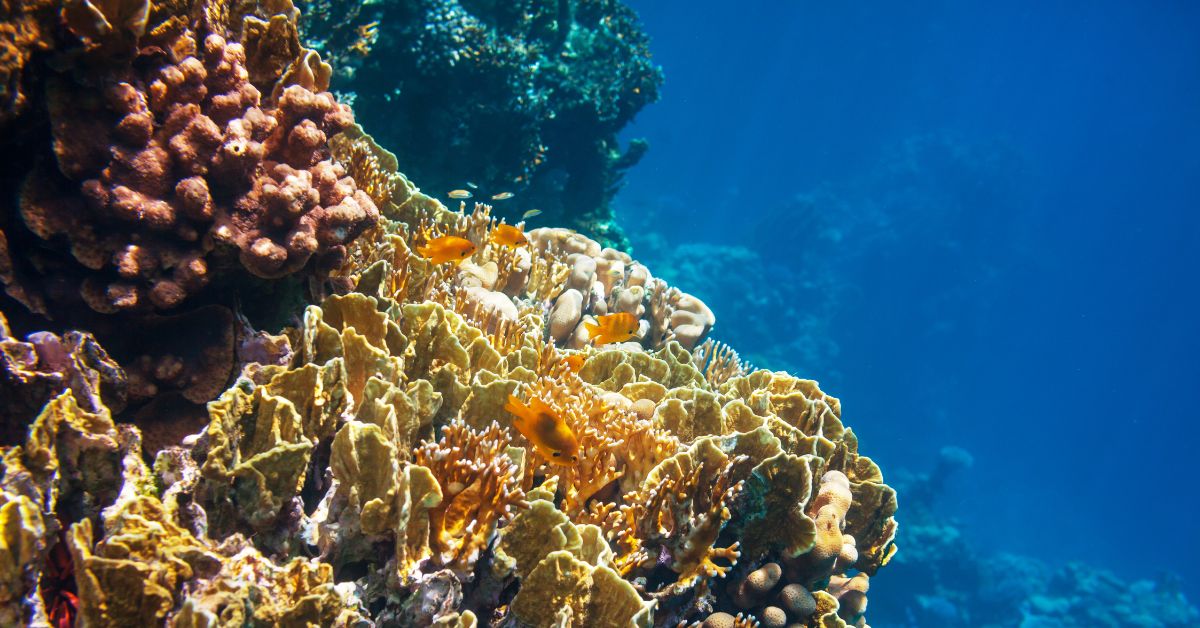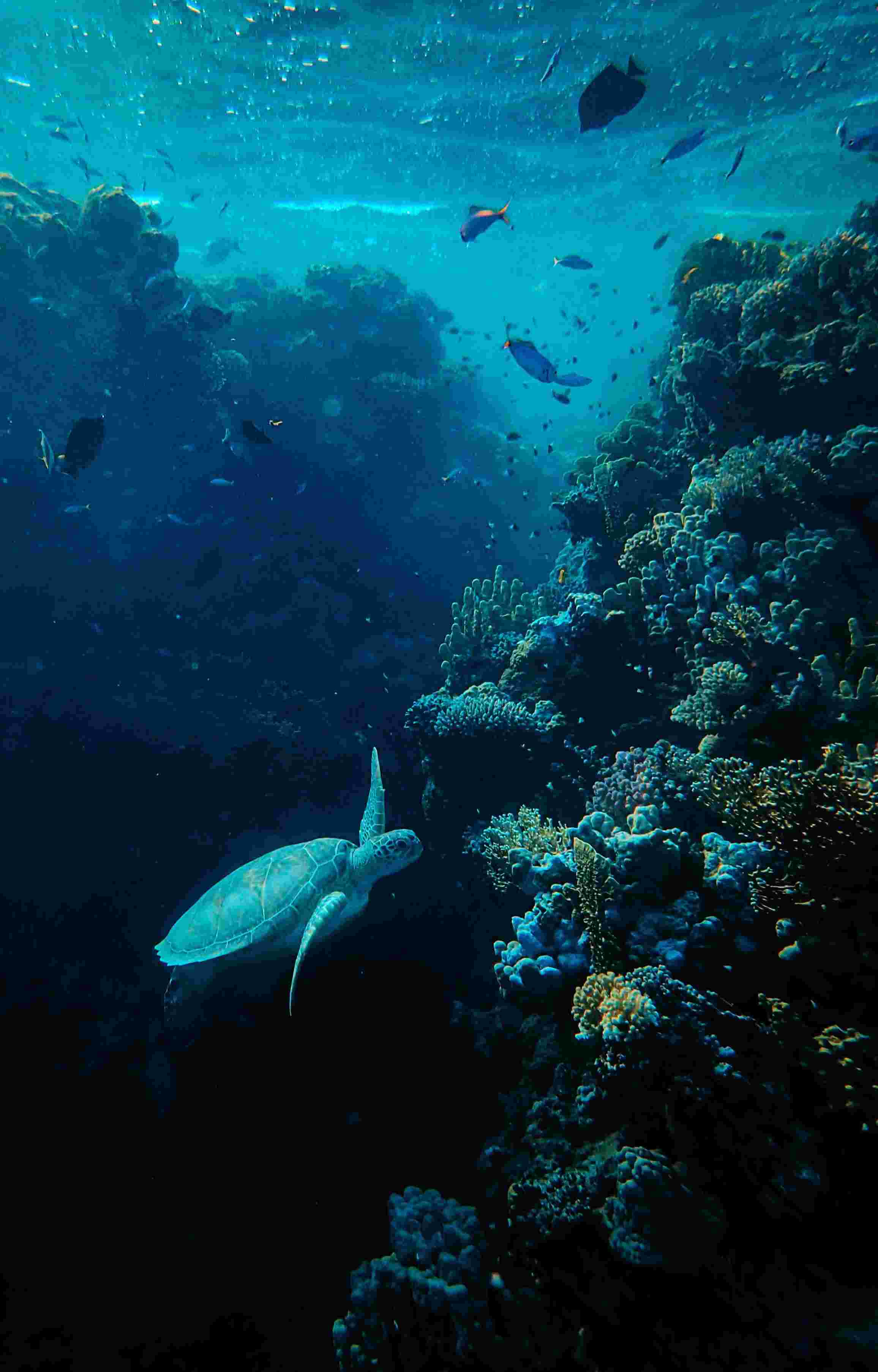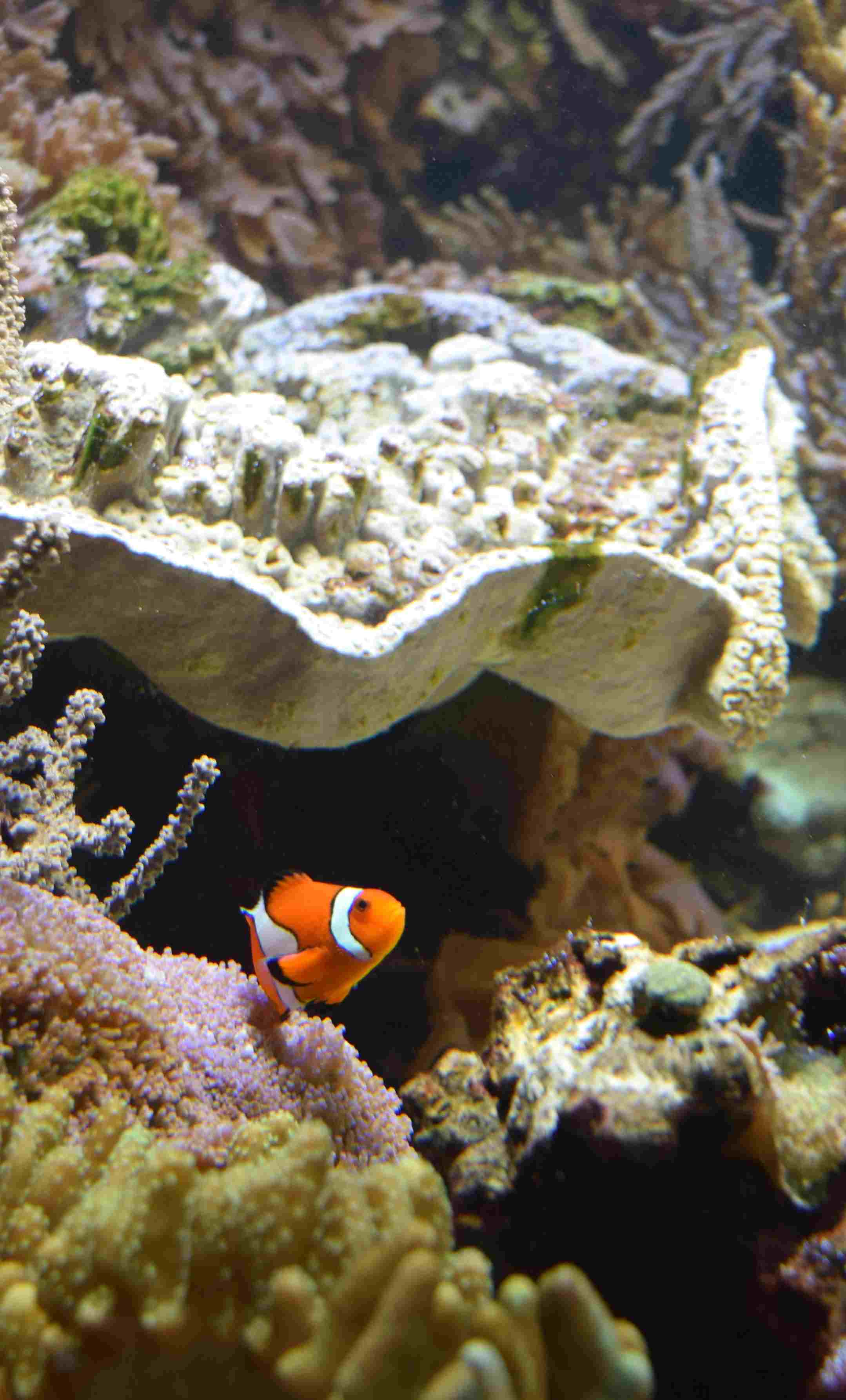
A coral reef is a rocky ridge under the surface of the ocean that is created not through the oceanic uplift or mountain building process - via plate tectonics - but by living coral. The rocky substrate that is a coral reef is made using thin layers of calcium carbonate produced by various corals.
The creation process is not an overnight event. It can take 30 Million years to create a sizable coral reef. That period is one of the reasons why so many people are concerned about the health of coral systems around the world.
What type of ocean life benefits from Coral reefs?
Earlier we mentioned that a coral reef is a coral community. These ecosystems are large and balanced. Around 25 percent of the organisms in the ocean are impacted one way or another by coral reefs. It may be that an organism lives there, feeds there, or finds shelter there. Small fish may find protection from larger predatory fish by tucking into the small nooks on the surface of the corals. A symbiotic relationship is found in the relationship - through evolution - between the clownfish and anemone.
In a Florida coral reef, you may encounter the Goliath Grouper which can grow large enough to swallow a diver whole. Other predatory fish also call reef systems home - moray eels, sharks, octopus, and even marine mammals make up a partial list of predatory inhabitants of a coral community.
In general terms, a coral reef is made up of:
- Producers - those organisms that make the coral layers
- Consumers - those organisms that fee on the coral or coral community
- Decomposers - those organisms that either feed off of the remains of organisms that have died or off of the coral structure itself
What is a memorial reef?
A memorial reef or living reef memorial is an eco-friendly burial option for those people who want their remains to give back to the earth and who do not want a traditional burial.
Traditional burials are not environmentally friendly. Not only do they consume natural resources such as wood and metal, but the process is also often full of toxins that leach into the ground and groundwater.
Because of the time it takes for a reef to form, and the fact that the world's population of reefs is declining, artificial reefs are necessary. A memorial reef is a spot where the cremated remains of people are placed. By using cremation urns for ashes and encasing them in the reef, the urn and ashes become part of the living community of a reef system.
The process mixes cement, sand, crushed seashells, and cremated remains - a solid mass that is then installed on the seafloor. These artificial reef systems grow each time remains are added. Once the solid form is placed, nature takes over and as time passes, creatures begin to build and live within the artificial reef. It is a transformation that changes the artificial into a living reef.
How exactly does a memorial reef work?
The process mixes components - sand, crushed seashells, cement, and cremated remains into a compound that forms a solid object, much like a sidewalk. The wet mixture is formed into an artificial reef by pouring it into a mold. Once in the mold, the mixture cures for a minimum of 30 days to ensure that it is fully solidified. From that point, the formation is transported to its final location and installed on the seafloor.
The hardened remains rest on the ocean floor where the natural reef-building processes begin. First, come the producers - algae which begin to attach to the structure and form small frilly tufts where baby fish begin to live. Other producers come and begin to build the corals. From there consumers appear to feed on the smaller organism which is busy making more producers. The decomposers are the last group to appear and by now you have the makings of a fully functioning reef community.
How are memorial reefs considered reefs?
The solid formation does not make it a reef. It’s rafting material on which a natural reef begins to form. The process begins when brown algae attach to the cement and remains structure. From there coralline algae also begins to attach itself to the structure and in a short amount of time, the structure is home to the small organism, small fish, and the process of building a reef community is underway. As more time passes the web of life that attaches to the structure improves and develops and larger species of reef organisms begin to call the structure home.
Once the solid remains structure is placed, the natural reef-building processes take over, and a living reef forms and continues to grow. As the reef matures, you would not know that it was formed around an artificial base. The benefits of all the living organisms and the physical structure of the reef transfer to the ocean and the community around it.
How do memorial reefs help reduce pollution?
While traditional funerals are widely practiced, more people are beginning to focus on the carbon footprint left behind in the process and the environmental impact re the embalming fluids to the materials, glues, and varnish of the casket. These are all buried along with the body, and it can take decades for the body to complete the decomposition process.
The living reef becomes encased in living material as the reef grows the artificial aspects of the reef become covered and a living, a thriving community emerges. Some living reefs encase custom cremation urns for ashes in the cement mixture rather than the ashes themselves.
Overall, a living reef burial is an option to remove the negative environmental aspects of traditional burials and replace them with the foundation that will become a living reef. Since reef structures are on the decline and the time it takes to create a natural reef can be millions of years long, the living reef helps replace ocean reefs which improve the oceanic reef environment. Additionally, all the benefits of a natural ocean reef also are present in memorial reefs.
Do memorial reefs need to be maintained?
No. The reef and remains once deployed and installed take on a life of their own. The natural reef-building process begins and continues unimpeded. The only danger to a reef or memorial reef is pollution. The maintenance of a memorial reef is simply to remain vigilant against oceanic pollution.


What happens to the ashes of a person in the memorial reef?
The ashes and cement mixture are sealed so that they remain protected until the natural reef-building mechanisms seal the unit away. That process can take time, but the ashes remain sealed from the ocean.
Once the cement structure is covered by living material, the reef will last for many decades if not millennia. If it takes 30,000,000 years to build a large reef naturally, you can expect that an artificial reef will last for a very long time. The only enemy of a reef system is pollution. If we keep ocean pollution to a minimum, reef systems will thrive.
Pros and Cons of memorial reefs
The pros of internment into a memorial reef and of the reef itself are many. The biggest pro is that a memorial reef removes the long list of environmental negatives that are traditional burials. These include using embalming fluids, which are toxins, and the use of raw materials like wood and steel, which are then lost to the recycling process. There is also the very long amount of time it takes for a body in traditional burials to decompose - upwards of 30-years
When you or a loved one chooses a memorial reef interment there are just the ashes, cement, aggregates, and seashells. The biggest con of creating memorial reefs comes from the usage of cement. That process is offset by the manufacturing process of cement which produces carbon dioxide - a greenhouse gas. Most reef memorial interments weigh about one quarter of a ton or about 500 pounds. It is a small amount of cement in the greater scheme of things and eventually, it becomes the base of a living community that offsets the small amount of carbon dioxide produced to create the cement that becomes the reef.
Living memorial Reefs offer an option for afterlife care that are mostly positive. By removing the terrestrial components of traditional burials, a living reef removes the many levels of toxins from the ground and groundwater.


Water and environmental awareness
Critics of living memorial reefs are concerned that the process may cause water or environmental damage. It is a small concern considering the larger impact of man-made water pollutants, which include garbage, plastic, chemical runoff, fertilizers, oil spills, and other environmental components that lead to a far greater impact on oceanic and terrestrial life.
Another form of green burial is alkaline hydrolysis cremation. The process uses liquid and lye to dissolve the body, which is placed into a tank where the liquid is heated and pressure is applied. The process melts the body and in as little as four hours, all that remains are bones. Overall, the process uses only 25 percent of the energy consumed in a traditional cremation and the liquid is treated and purified. If you are looking for a fast and eco-friendly alternative to traditional burial alkaline hydrolysis cremation is a viable option.
How many individual interments would it take to make real tangible differences in the immediate ocean environment?
Considering that a burial interment at a reef is about five feet long by five feet tall, real impacts could occur at small levels of burials. Twenty-five burials would create a reef structure that is five x twenty-five or 125 feet long. That is the beginning of a tangible reef. At one hundred burials, the living reef becomes 500 feet long. These are small in comparison to the largest naturally occurring reefs -the Great Barrier Reef is 1,429 miles long. Even small reefs make positive impacts against coastal erosion and help to counter oceanic pollution.
Other Applications of Cremated Remains with Environmentally Friendly Results
There are a few options available for green burials and many of them could incorporate cremated remains into their process.
- Mushroom coffin - uses mycelium and wood chips to create a casket that when placed in a moist area becomes alive and decomposition of the body placed inside occurs. The process takes about three years which is considerably faster than traditional burials where the decomposition process can take 30 years. Instead of using a body, the cremated remains could be mixed into the material with the wood chips and mycelium to form a decomposable block that would disappear in a fraction of the time needed to decompose a body.
- Scattering Ashes - A popular way to inter a loved one is to scatter their ashes, which places the person in nature, and preferably in a natural setting that they loved, such as a national park, at sea, by air, etc. With permission, the cemented burial ball could become a rock in a park or at sea, or placed in a location where it would degrade over time and disappear.
- Ocean Water Burial - Spreading ashes at sea is a very popular modern take on an older tradition of burial. The views we have of traditional burials are changing because society itself is changing. We no longer live in tight family-centric communities. Our children live around the world, and we as parents are gone, there is no point in burying our bodies in a family plot where few family members will return to visit us. That process opens the door to a greater spiritual connection of spreading our ashes in the sea, where the oceans become our spiritual link to our living loved ones. We go to the beach to remember and connect with those that have departed.
- Biodegradable Urns - Cremation urns for ashes can be a forever resting place or a biodegradable and environmentally friendly resting place. Biodegradable urns and custom cremation urns for ashes disappear leaving no negative impact on nature. They are designed for water or land and as they disappear and degrade, the remains inside become one with nature. Biodegradable urns are available at In the Light Urns.
- Tree/gardening planting with ashes - There are a few ways that this new concept address burials. First, the garden plants take up the ashes as nutrients and thrive. Another way is to be planted in a special biodegradable basket with a tree. As the tree grows the body decomposes and feeds the tree. These ideas are incredible ways to remove and reduce the expanded carbon footprint of death and burial.
If you are one of the many people interested in offsetting the carbon footprint of traditional burials, then consider the many benefits of a living memorial reef or other green option for burial.


How do coral reefs impact our lives or the environment?
Many people ask "why is it important to protect ocean life through reef protection and development?" It is not an easy question to answer because coral reefs offer benefits across many applications and the impact of coral reefs touches nearly everybody on earth. Here's a deeper look into why oceanic life and reefs are important and why protecting them is a must.
Protection of the Coastline - Coral reefs help to protect the coastline from coastal erosion and damage from big waves. That also includes reducing storm surges in the face of a hurricane or property damage from waves that crash onto land above the high tide mark. So, a coral reef is a form of land protection against the massive force of the sea.
Biodiversity - A healthy and large coral reef may become home to more than 4,000 species of aquatic life. They are the driving force in a very diverse ecosystem with lifeforms that range from microscopic to large and predatory fish such as the Goliath Grouper. Such a vast and beautiful ecosystem is also a source of food fish for humans.
Cleaning the Oceans - Many of the small organisms that live in a coral reef are filter-feeders, which means they help to clean the ocean water of small organisms such as plankton and zooplankton.
Benefits to Humans - Organisms that live in coral reefs and the physical structure of coral reefs are sources of important medications that treat common issues, such as Asthma, heart diseases, some forms of cancer, and even joint diseases.
The inflow of money to local communities - Tourism is a big deal to local coastal communities and coral reefs are a mega-attraction. Even artificial coral reefs draw tourists whose vacation dollars help to support many small communities.
Sadly, coral reefs are dying. It is estimated that the world has lost about 50 percent of its coral reefs over the last three decades. Considering that coral reefs take only one percent of the ocean floor, it might seem like a small thing. The other side of that coin is that coral reefs contribute to more than 25 percent of all ocean life. In addition, as the world loses more reefs, we also lose access to new resources such as medicines, protection for coastal communities, and loss of food and tourism.
The current status of coral reefs
Currently, the world has lost about 50% of its coral reefs. The damage comes from both local and global sources and can include water-based and land-based threats.
A big threat to coral reefs is land-based runoff such as fertilizers from farming and lawn care, toxins from wastewater, and water-based issues such as boating. There is also the damage to coral reefs from illegal mining and specimen collecting. [1]
The big garbage patch in the ocean also poses a threat and brings us to a local basis where plastics and microplastics enter the picture. Local pollutants are a big deal and a major threat to coral reef ecosystems. Lost fishing gear, hooks, lures, lines, and common plastics such as plastic bags and bottles are all examples of pollutants that negatively impact the health of reef systems.
The Global Impact on Coral Reefs
The damage to coral reefs is not isolated to local issues. Many issues impact the health of coral reefs that are more of a global issue rather than a local problem. A decreasing food supply means a decrease in the populations of reef organisms. Like other food webs, when the smallest creatures - those that would dine on algae - decline, their loss is felt from the bottom of the food web to the top level where apex predators go hungry.
Global sea temperatures are rising, and that process decreases the ability of alga to form which is a considerable food source for organisms that live within coral reef systems. The loss of coral alga also causes coral reef bleaching. Climate change also impacts coral reefs. Increased sea depths, variations in weather, larger and unpredictable storms, and other weather-related phenomena disrupt the ecosystems and food webs that sustain coral communities. Climate change also disrupts the carbon cycle which leads to higher acid levels in ocean waters. The material that coral reefs are constructed from - calcium carbonate - melts when exposed to acids.


What are some of the more recognized agencies that help protect/preserve reefs around the world?
In the US many organizations work to protect or restore coral communities. Those include:
- The Environmental Protection Agency
- NOAA
- National Coral Reef Institute (NCRI)
- National Center for Coral Reef Research
Around the world, other nations have organizations that protect the precious coral communities. In Australia, the Great Barrier Reef Marine Park Authority is the agency in charge of the world's largest coral reef - aptly named - the Great Barrier Reef, which stretches over 1,429 miles.
Even the United Nations is working to protect coral reefs around the world from the global impact on reef systems. They are working to change environmental laws to strengthen and protect the systems that oversee coral communities.
What parts of the planet are coral reefs found?
Coral reefs are found around the world, generally between the 30th parallel North and the 30th parallel South. The biggest coral reef is The Great Barrier Reef off the coast of Australia. There are coral reefs off the coasts of Florida, the West Atlantic and East Atlantic, and the East Pacific oceans. There are coral reefs off the coast of many countries.
Some of the most famous coral reefs include:
- The Great Barrier Reef - Australia
- Amazon Coral Reef - Northern Brazil
- Tubbataha Coral Reef - Philippines
- Miami Terrace Reef - Florida
Given the number of coral reefs, the challenges they face, and the fact that they are in decline, people have begun to create artificial reefs.





